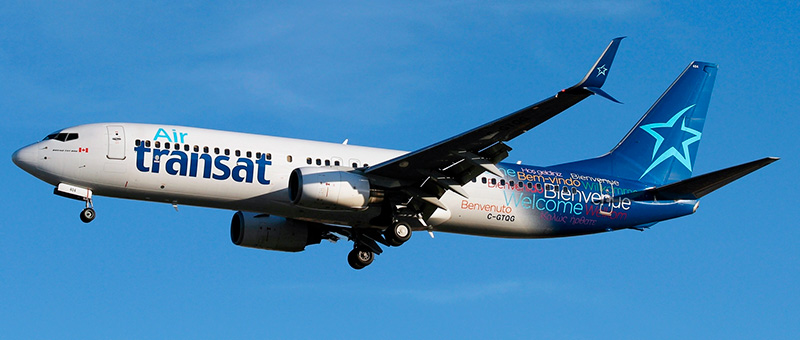
Seat map Boeing 737-800 “Air Transat”. Best seats in the plane
Air Transat operates 2 versions of Boeing 737-800.
First cabin version of the Boeing 737-800. V1 International
First version of Boeing 737-800 is used during international flights.
This airplane may accommodate 189 passengers. All the seats on this airplane are economy class seats divided into 3 sections.
First section consists of 14 rows of seats: first row with 3 seats and 13 rows have 3-3 configuration. The best seats in this section are considered the seats 1ABC and HJK seats of the rows 2-5. Passengers of these seats will feel comfortable thanks to extra legroom. An extra fee must be paid to book these seats. Among disadvantages of the seats 1ABC and 2HJK: reduced width because the tray tables are in the armrests making them immovable, lack of floor storage during take-off and landing and location of the lavatories in front.
Because of the exit row located behind the seats of the 14th row are less reclining than standard.
Second section of economy class seats contains just 1 row. As the seats of the 15th row are located between two exit rows, on the one hand they offer additional legroom to passengers but on the other hand have limited recline. To book these seats an extra charge must be paid. Also, these seats have no floor storage during take-off and landing and have reduced width.
Behind the exit row the third section of economy class seats is located. There are 17 rows of seats here. Passengers of the seats of the 16th row will take advantage of extra legroom. Extra fee must be paid to book these seats. However, tray tables that are built-in the armrests reduce the width of these seats a little. No floor storage during take-off and landing is another disadvantage of these seats.
Proximity of the lavatories is the main disadvantage of the seats 31C and 31H.
The seats of the 32rd row are considered bad seats because they are less reclining than standard and are located close to the lavatories.
Second cabin version of the Boeing 737-800. V2 Domestic
Second version of Boeing 737-800 is operated on domestic flights.
This airplane offers seats of 2 classes: club seats that correspond to business class and economy class seats.
Business class seats are AC seats of the rows 1-3 and HK seats of the rows 2-3. I.e. there are totally 10 business class seats on this airplane. B and J seats are blocked in these rows providing more extra space to passengers of business class. Because of the bulkhead the legroom of the seats 1AC and 2HK is restricted. Location of the lavatories in front and lack of floor storage during take-off and landing are another disadvantages of these seats.
Economy class may accommodate 174 passengers. Extra legroom of the seats HJK of the rows 4 and 5 makes these seats good seats to book which an extra fee is charged.
The seats of the 14th row have limited recline due to the exit row located behind.
Passengers of the seats of the 15th row will feel comfortable thanks to additional legroom. However to choose these seats additional fee must be paid. As the tray tables are built-in these seats the width of these seats is slightly reduced. In addition, these seats have no floor storage during take-off and landing and have limited recline because of the exit row located behind.
Other seats to book which an extra fee must be paid are the seats of the 16th row. Air Transat designates these seats as seats with extra space for passengers’ legs. However, these seats have no floor storage during take-off and landing and have reduced width because the tray tables are in the armrests making them immovable.
Lavatories located behind may cause discomfort to passengers of the seats 31C, 31H and of the seats of the 32nd row. Limited recline is another disadvantage of the seats of the last 32nd row that makes these seats bad seats.
Usefull information about “Air Transat”
- Rating and reviews about “Air Transat”
- Boeing 737-800 Air Transat. Photos and description of the plane
- Air Transat – company description and aircrafts fleet


